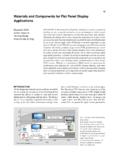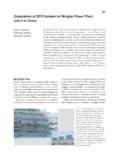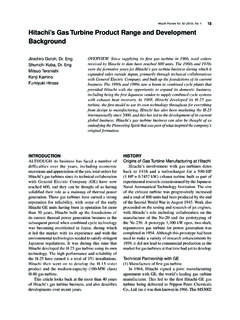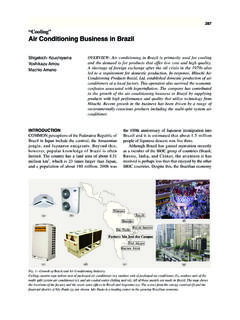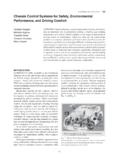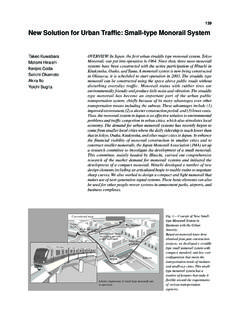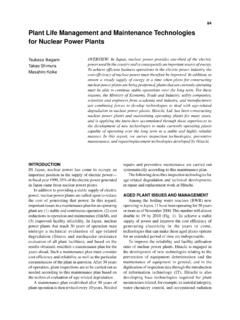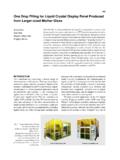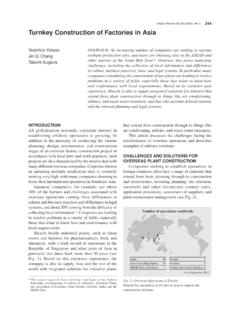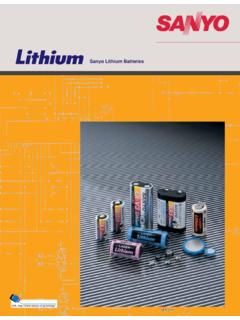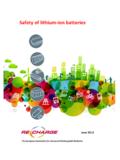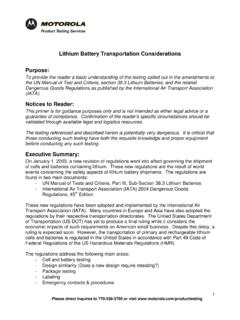Transcription of Automotive Lithium-ion Batteries - Hitachi
1 Hitachi Review Vol. 60 (2011), No. 1 17. Automotive Lithium-ion Batteries Koji Higashimoto OVERVIEW: Activity has been picking up in the fields of hybrid and plug- Hideki Homma in hybrid electric vehicle development because of the role they can play Yasuo Uemura in solving increasingly severe global environmental problems. Hitachi is working on the development of Lithium-ion Batteries , the key devices for Hidemasa Kawai these vehicles. Development of the third generation of cylindrical Batteries Shoji Saibara is now complete and they have been selected for use in hybrid vehicles to be Kensuke Hironaka produced by US firm General Motors Company from 2011. Also currently under development are a fourth generation of high-output Batteries and new prismatic cells for plug-in hybrid vehicles. INTRODUCTION (W/kg) HEV. Output power density (acceleration performance). WITH the need to deal with global environment 5,000 Fourth generation (under development). problems growing in importance, attention is being 4,000.
2 Directed toward solutions to the problems of energy PHEV. use. HEVs (hybrid electric vehicles), PHEVs (plug-in Third Development 3,000 generation model hybrid electric vehicles), and other vehicles that use Second In production rechargeable Batteries have been commercialized and generation 2,000 New prismatic cell First their use is rapidly becoming more widespread due to generation (under development). both their environment performance and economics. 1,000. Although the rechargeable Batteries currently used in most of these vehicles are Ni-MH (nickel metal 0. 0 50 100 150 200. hydride) cells, Lithium-ion Batteries have higher Energy density (endurance) (Wh/kg). output and energy density and their use is growing. HEV: hybrid electric vehicle PHEV: plug-in HEV. This article describes the third-generation HEV. Lithium-ion Batteries selected by General Motors Fig. 1 Improving Performance of Hitachi Automotive Company (GM) for use in their HEVs, Hitachi 's work Lithium-ion Batteries . Hitachi has been working on improving battery output power on the next generation of HEV and PHEV Batteries and energy density through in-house development using currently under development, and the outlook for manganese-based cathode materials as a base.
3 These products. PAST ACTIVITIES First generation 2000. 2000. 2001 2002 2003. 2003. 2004 2005. 2005. 2006 2007 (Year). (HEV). Hitachi has been developing Automotive lithium - ion Batteries since the 1990s and led the world in the production and bringing to market of Batteries with Nissan Motor Co., Ltd. East Japan Railway Isuzu Motors Limited high performance and long life. Tino Hybrid Company Elf Hybrid NE Train Fig. 1 shows the evolution of battery performance Second generation 2005 2006 2007 2008 2009 2010 2011 2012 (Year). 2006 2007 2007. over successive generations. (HEV). Although energy density and output power density are conflicting performance attributes, Mitsubishi Fuso Truck East Japan Railway Mitsubishi Fuso Truck steady progress has been made through ongoing and Bus Corporation Company and Bus Corporation Canter Eco hybrid Kiha E200 Type Aero Star Eco hybrid development of the active materials that play a key Koumi hybrid railcar role in Batteries . Fig. 2 Electric Vehicles Equipped with HEV Lithium-ion These Batteries have been used in a diverse range Batteries .
4 Of vehicles since the release of the first generation Hitachi 's Batteries have been used in a wide range of different and have already built up a market track record vehicles where they have demonstrated a high level of system spanning more than ten years (see Fig. 2). The reliability. Automotive Lithium-ion Batteries 18. second-generation Batteries now in full production of the active material surface. Also, the battery's have an output power density of 2,600 W/kg and have structure was designed to minimize the length of recorded total sales in excess of million cells. the cathode and anode leads and improvements were made to the welding methods to reduce the electrical THIRD-GENERATION HEV Lithium-ion resistance. BATTERY Fig. 3 shows a photograph of the third-generation Hitachi developed its third generation of lithium - battery, Fig. 4 shows a comparison of the input and ion Batteries with high output power and long life to output power characteristics of the second- and improve the performance of HEVs.
5 Third-generation Batteries , and Fig. 5 shows how the output power of the third-generation battery varies Battery Features and Performance with temperature. Table 1 lists the main specifications of the second- Another key objective during battery development and third-generation Batteries . was to improve its calendar life. HEVs require The third-generation Batteries feature a high Batteries with a life of ten years or more. Having output power density of 3,000 W/kg together with excellent battery life characteristics means that the small size and light weight. Materials-based changes aimed at improving the output power included optimizing the proportion of lithium and other metals 6,000. Second-generation Second-generation output power input power in the manganese-based cathode and microstructure Third-generation Third-generation control to reduce the charge transfer resistance 5,000 output power input power Input/output power (W/kg). 4,000. TABLE 1. Main Specifications and Production Status of Second- 3,000.
6 And Third-generation Batteries The main specifications of the second-generation Lithium-ion 2,000. battery currently in full production and the third-generation battery due to go into production in 2011. 1,000. 10-s input/output power at 25 C. Second-generation Third-generation 0. battery battery 0 20 40 60 80 100. Enters production in SOC (%). Status In production 2011 SOC: state of charge Cell shape Cylindrical Cylindrical Fig. 4 Input and Output Power Characteristics of Second- Improved Cathode material Manganese-based and Third-generation Batteries . manganese-based Anode material Amorphous carbon Amorphous carbon The third-generation battery has an output power density of Capacity (Ah) 3,000 W/kg at a 50% SOC. Weight (kg) Power density (W/kg) 2,600 3,000. 8,000. 30 C 10 C. 0 C 10 C. Output power density (W/kg). 25 C 40 C. 6,000. 50 C. 4,000. 92 mm 2,000. 0. 0 10 20 30 40 50 60 70 80 90 100. 40 mm SOC (%). Fig. 3 Third-generation Lithium-ion Battery. Fig. 5 Output Power Variation with Temperature for Third- The new generation is based on a highly reliable cylindrical generation Battery.
7 Battery of which more than million cells have already been At -30 C, the battery has an output power density of 300 W/kg sold. at a 50% SOC. Hitachi Review Vol. 60 (2011), No. 1 19. 100 Inlet 95. Sustained output ratio (%). 90. 85. 80 Third generation Second generation 75. 70 Battery kept at 50 C and 50% SOC. 65. 60 Outlet 0 50 100 150 200 250 300 350. Storage time (d). FEM: finite element method Fig. 6 Calendar Life Characteristics of Second- and Third- Fig. 7 Result of FEM Analysis of Cell Temperature in Battery generation Batteries . Pack. The significant improvement in the characteristics of Batteries The cell layout, cooling flow, and other parameters were kept at high temperature allowed battery size to be reduced. optimized to reduce cell temperature rise, minimize the variation in temperature between cells, and reduce pressure loss in the flow path. TABLE 2. Abuse Test Results No evidence of rupture or fire was seen under any of the test conditions. Battery Pack Development Result Test Test conditions (EUCAR.)
8 Battery systems for HEVs require that the Batteries Hazard Level*) be combined into packs made up of multiple cells Nail SOC 60%, 70%, 80%, 90%, 100%, 3, 4 connected together. Lithium-ion Batteries also require penetration @55 C. a monitoring system to monitor each cell. Accordingly, 255 kgw (2,500 N)-5 min Crushing 2 Hitachi has developed battery packs that meet GM's SOC 60%, 70%, 75%, 80%, @55 C. External Circuit resistance: < 5 m (1 m ). 2 requirements. short circuit SOC 60%, 70%, 75%, 80%, @55 C. Each pack consists of two 16-cell modules made up From 100% to 200% SOC. Overcharge 2 of two blocks of eight cells with the battery monitoring 32A-CC charge @55 C. Over- From 100% to 100% SOC 1CA. 2. module located on top of the battery modules. discharge @55 C. In addition to essential mechanical requirements Max. temperature: 250 C, Rate of change: 5 C/min such as vibration and shock resistance, a key Hot box 3. 5 C steps, 30 min hold time focus in pack design is how to handle temperature SOC 60%, 70%, 80%.
9 Management. The air cooling layout and operating EUCAR: European Council for Automotive R&D CC: constant current * Level 4: More than 50% of electrolyte discharged from battery, Level 3: More conditions needed to reduce the overall temperature than 50% of electrolyte remains in battery, Level 2: No venting or leakage rise as well as inter-cell temperature variation are determined through repeated iterations of simulation and experiment. Also, to ensure the safety of the level of performance degradation is low and also vehicle cabin if an abnormal situation arises, the pack helps make Batteries smaller because it allows active is designed so that the cooling draft and gas exhaust materials to be used effectively. grooves are entirely separate. Fig. 7 shows an example Fig. 6 shows the output power temperature of the simulation. characteristics of the second- and third-generation A new custom ASIC (application-specific integrated Batteries and the calendar life when maintained at a circuit) with an enhanced self-diagnosis function was temperature of 50 C.
10 Developed for use in the battery monitoring system. The improvement in calendar life was achieved Functional safety testing was performed and an end- mainly through improvements in the anode structure to-end diagnostic process that extends from the cell and new electrolyte additives. voltage input to the microcomputer was developed to The safety of the Lithium-ion Batteries was also implement a non-redundant architecture. confirmed through extensive testing. Table 2 lists the Each custom ASIC chip can monitor four or main tests and their results. No evidence of rupture six cells. Fig. 8 shows the structure of the battery or fire was seen under any of the test conditions. monitoring system. Automotive Lithium-ion Batteries 20. Power supply 32 CC OSC. cells Voltage detection COMM2 COMM1. Logic circuit MPU. Diagnostic circuit ASIC. Fig. 9 Production Line (Cell Assembly Line at Hitachi ASIC: application-specific integrated circuit CC: cell controller MPU: micro-processing unit OSC: oscillator COMM: communication Vehicle Energy, Ltd.)
